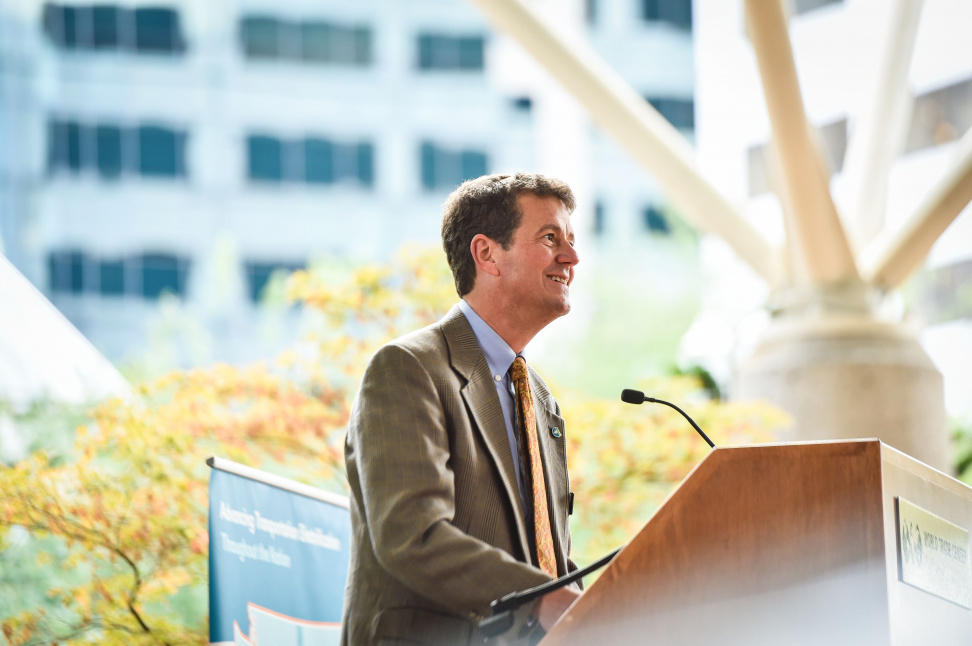
The Case for an Efficient, Equitable Transportation Strategy
By: Jeff Allen, Executive Director, Forth.
I’m not sure who first coined the phrase “circular firing squad,” but I’m pretty sure transportation advocates have perfected the art form. One of the most durable, frustrating, saddest threads through the years has been the false conflict between different transportation strategies and goals. Advocates for transit, bikes, good land use policy and walkable cities square off against advocates for cleaner vehicles; both of those groups square off against advocates for more rational road pricing to reduce congestion, and groups working for cleaner transportation systems are in recurring conflict with groups fighting for better transportation access to jobs and other basic needs. Meanwhile, people and goods transport continue to depend almost entirely on expensive and highly polluting systems.
Let’s talk about the environment first. A national switch to electric vehicles would reduce carbon pollution by 60% to 80% based on the current electricity grid, while completely eliminating toxic diesel exhaust and smog-forming tailpipe emissions. The result of decades of advocacy work is cleaning up the power grid even further, pushing the pollution impacts of electric vehicles even closer to zero. If our only goals were to address climate change and clean air, switching all vehicles to electricity immediately would largely solve those problems. But that's not going to happen immediately, or anything close to it.
As a recent NY Times piece pointed out, with some great visuals: cars last for decades, and it’s going to take decades for the fleet to turn over. We need to reduce the growth in vehicle miles-of-travel (VMT) as well, especially while the fleet of functioning vehicles is still a long way from carbon-free. That means we need shared vehicles, better alternatives to driving, and more rational transportation pricing systems that stop subsidizing oil production and rush hour commuting. Furthermore, even if we could magically convert everything that moves to electricity overnight, that would do nothing about the water pollution from acres of roads and parking lots, the resources used to make the cars, or the obesity that stems from a car-centered lifestyle.
Then there are the economics of the transportation system. Most cars sit parked 95% of the time, and in the U.S., when they are moving, they carry an average of just 1.08 people, meaning we’re only using about 1.35% of their capacity. That’s an incredible waste of an expensive asset. Little wonder that mobility is the second-highest household expense for most families, averaging around $9,500 per year. Because of our poorly designed systems and unwillingness to use smart pricing and other demand management strategies, traffic congestion cost us $88 billion while wasting nearly 100 hours of the average American's life in 2019. Car crashes kill some 40,000 Americans a year and over a million globally. Converting to electric vehicles can help reduce operating costs and keep more money circulating in our local economies, but by itself, electrification is only marginally helpful with any of these challenges.
Things get even more complex when we bring an equity lens to bear. Communities of color bear the brunt of air pollution from traffic, and they also spend a higher percentage of their income on transportation and tend to rely more on unreliable and polluting vehicles that are expensive to maintain – or on transit systems that are rarely funded well enough to be as convenient as a private car. Commute time is the greatest predictor of escaping poverty – and in almost every corner of America, the fastest commute is in a private car. Crucially: none of this is an accident. These outcomes are the result of decades of public policy and investment. Redlining and race-based lending practices forced communities of color into particular neighborhoods; urban planning and renewal policies forced freeways into and through these neighborhoods; investments in transit, walking, and biking were made elsewhere; in short, transportation policy has all too often reinforced racial inequality.
Building a more sustainable, efficient, and just transportation system is complicated. There are no simple solutions. We need to electrify everything that moves; share more vehicles so that expensive equipment gets used more; make it easier to walk and bike; build more livable communities through smart land use planning; invest more heavily in transit; develop pricing that more accurately reflects actual transportation costs and do a whole lot more besides. There is a lot of work to do, but one thing I know for sure: arguing about which solution is “most perfect” will not help anyone.
A version of this post appeared in the Portland Business Journal in April.


